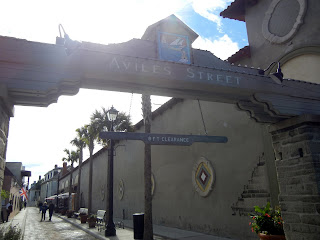We have had a cool day in St. Augustine---59 degrees in the mid-afternoon. But at least there was no snow!
We did a self walking tour which took about four hours, including a stop for lunch. We began at the Public Burying Ground which was set aside for the interment of non-Catholics when a yellow fever epidemic occurred in 1821. It is located outside the gate to the old city.
I found the Castilo de San Marcos fascinating. It reminds me so much of Ft. McHenry because it is constructed in the "bastion" system which is the star-like outline. Work began in 1672 making it one of the oldest standing structures in North America. There were men dressed in period costume of the Spanish soldiers who manned this fort. One of them gave a talk and he made it come to life for us.
They also fired the one of the cannons. The ball from this cannon could travel 1 1/2 miles.
This is a link to a 360 degree photo of the fort:
http://360.io/jSKMkt
The Bridge of Lions connects downtown St. Augustine with Anastasia Island. From its earliest days it was hailed as "The Most Beautiful Bridge in Dixie". Two marble lions guarded the bridge on the old town St. Augustine side. Completed in 1927, the original bridge was in service 80 years before it was declared unsafe and had to be torn down and the bridge and the lions were replaced.
Ponce de Leon was the first European to discover Florida in what most historians believe was 1513. He claimed the land for Spain. It was interesting to learn that he stood 4' 11". There is a life sized statue of him.
Aviles Street is the oldest street in St. Augustine. It reminded us very much of some of the places we have seen in Italy and France.
Trinity Parish Church (the Church of England was established in Florida during the British occupation) (1763-1784).
Plaza de la Constitution, which was established in 1573, is the oldest public park in the continental United States. The word Constitution refers to Spanish Constitution of 1812. The Plaza holds a monument to that document, a seventeenth century well and a Confederate Veteran’s Memorial.
The Cathedral Basilica is the seat of the first Catholic parish in the United States and was completed in 1794. When the diocese of St. Augustine was created in 1870, the church became a cathedral. The cathedral was elevated to a minor basilica by Pope Paul VI in 1976. I noticed that most of the beautiful stained glass windows showed various scenes in the life of St. Augustine.
One of the oldest wooden school houses in America, this building had one classroom and was co-ed. The schoolmaster and his wife lived above the classroom. No one knows when the school house was build, but it was listed on the city tax records as far back as 1716 when Florida was still in possession of the Spanish. There is an anchor and chain under the eaves which was supposed to keep the school from blowing away during hurricanes.
The Old City Gates, once the only entrance to the city of St. Augustine, were built in 1808 as a line of defense in conjunction with a wall that surrounded the city.
There are many activities going on in this city throughout all year and it would be a nice place to visit again and again---especially to escape the cold weather in Maryland!!!















This is something! I know I've been to St. Augustine a half dozen times... even though the last time I was still only about 9... maybe 10. But the ONLY thing you showed me that I remember is that ONE ROOM school house!!! LOL! And I'm positive, knowing my mother, that we visited that Catholic church! She probably made certain we were there on Sunday! What an interesting place! I will have to make a point of visiting again as an adult! :)
ReplyDelete